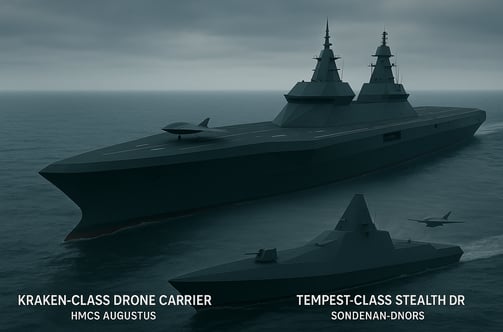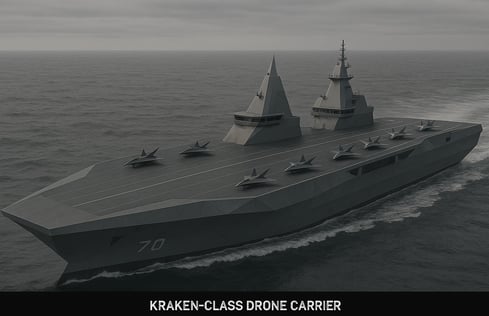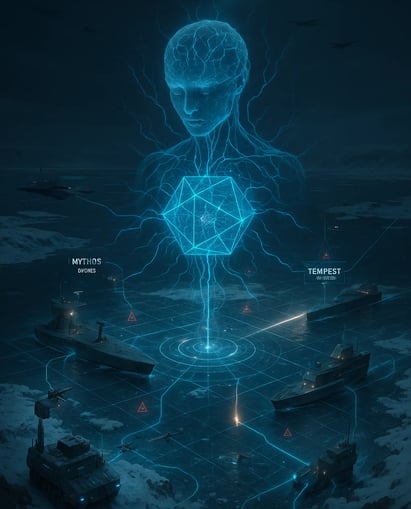Kraken Class | Drone Carrier
Naval Force Projection Reimagined
Lead Vessel: HMCS Augustus
The Kraken-Class Drone Carrier represents the future of Canadian maritime power—a 40,000-ton next-generation drone carrier purpose-built to project force through autonomous systems, modular strike assets, and long-range ISR capabilities. As the flagship naval asset in Project Borealis, the Kraken-class is designed to Lead or support unmanned aerial operations, amphibious landings, and sustained Arctic deployments—operating far from home ports with unmatched endurance and flexibility.


Key Features
Displacement: 40,000 tons
Propulsion: Small Modular Reactor (SMR) for extended missions
Drone Complement:
36 × Revenant Class Strategic UCAVs and
12× Mixed-Class Tactical Drones (MYTHOS-series)
200× Phantom Halo Micro-Drones
30 × Phantom Dagger Loitering munitions
Flight Deck: Reinforced deck with catapult and arrestor capabilities for drone operations
Hangar Bays: Expanded multi-tier hangar for drone storage, rearm, and maintenance
Troop Capacity: 200+ Marines
Vehicle Bay: Accommodates 4 THORUN units, main battle tanks, and light transports
Underwater Defence: Torpedos counter measures, towed sonar decoys, Anti - submarine rocket assisted torpedos (ASROC)
2 Phalanx CIWS (Close-In Weapon System)
Retractable turret, likely located mid-deck or near the superstructure for 360° coverage
Provides last-ditch defence against missiles, drones, and low-flying threats
64 Modular VLS (Vertical Launch System) Cells
Integrated into deck or below deck amidships
For SAMs, anti-ship, or hypersonic defence, Sea-Land (Long-range land attack cruise missiles LACMs)
Optional laser or DEW systems (future-ready)
8 x Ballistic missile defence interceptors
Electronic Countermeasures & EW Suite
Part of the Borealis AI integration
Spoofing, defensive jamming cyber warfare node, and decoy deployment
Future - Proof slots Directed - energy weapons / railgun option
Support Assets:
2 Helicopter Landing Pads
Integrated for HADR (Humanitarian Assistance/Disaster Response)
Desalination Systems for long-term humanitarian and forward operations


Kraken Class | Peer Warfare
Not Just A Concept But the Vision of the Future
The Kraken Class Drone Carrier is not only an asymmetric drone warfare platform but also a true peer/near pear adversary-capable flagship. It enhances offensive, defensive, electronic and operational capabilities to enable independent or group operations against modern blue - water navies and integrated land - based defences.
Direct Grounded Assessment
The Kraken-Class Drone Carrier is not just a drone arsenal platform but a strategic force projection asset, capable of competing against peer adversaries in specific operational contexts. Its strength lies in distributed lethality through Revenant-Class UCAVs, long-range standoff strike capabilities, advanced electronic warfare (EW), and AI-coordinated drone swarms for ISR and saturation attacks. Against Russia’s naval forces, including the Kirov-class battlecruisers and Oscar-class SSGNs, the Kraken, supported by its Tempest-Class destroyer escorts, could effectively neutralize surface threats via long-range precision strikes and overwhelm enemy ISR with drone saturation. Russian submarine threats remain the principal risk, but with coordinated ASW from Vanguard-class escorts (planned), the battle group can maintain parity or advantage, particularly in the Arctic or North Atlantic.
Facing PLAN carrier strike groups or a future PANG battle group, however, the Kraken’s relative lack of organic manned air cover is a limiting factor. While its stealth drones offer deep strike and ISR reach, adversary carriers bring fifth-generation fighters (e.g., J-35, Rafale NG) providing persistent CAP (Combat Air Patrol) and force protection. The Kraken Class Drone Carrier offsets some of that with hypersonic-capable missile batteries and directed-energy defences (future proof), but in an open-ocean confrontation, Kraken groups risk being outmatched in sustained air superiority and missile volume exchange. However, in asymmetric, Arctic, or choke-point operations, the Kraken battle group—with advanced EW, cyber capabilities, and a doctrine of denial and distributed attack—would likely retain qualitative overmatch, leveraging stealth, drones, and AI-driven decision cycles to offset adversarial numerical superiority.
Borealis Core Integration
The Kraken-Class serves as a maritime command node for Project Borealis:
Coordinated drone flight ops via Borealis Core AI
Autonomous mission uploads and pre-set swarm deployments
Shared situational awareness across air, land, and sea assets
AI-based maintenance diagnostics and fleet resource allocation
Mission Role
Carrier-based Drone Warfare & Surveillance
Arctic Expeditionary Force Deployment
Long-Range Strike Missions
Integrated Humanitarian & Recon Operations
Force Multiplication for Canadian Naval Task Groups
Strategic Advantage
Fully CANZUK-aligned architecture (Canada, UK, Australia, New Zealand)
SMR-powered energy independence
Encrypted battlefield networking and sovereign digital command stack
Domestic manufacturing pipeline with Canadian industry & academia

